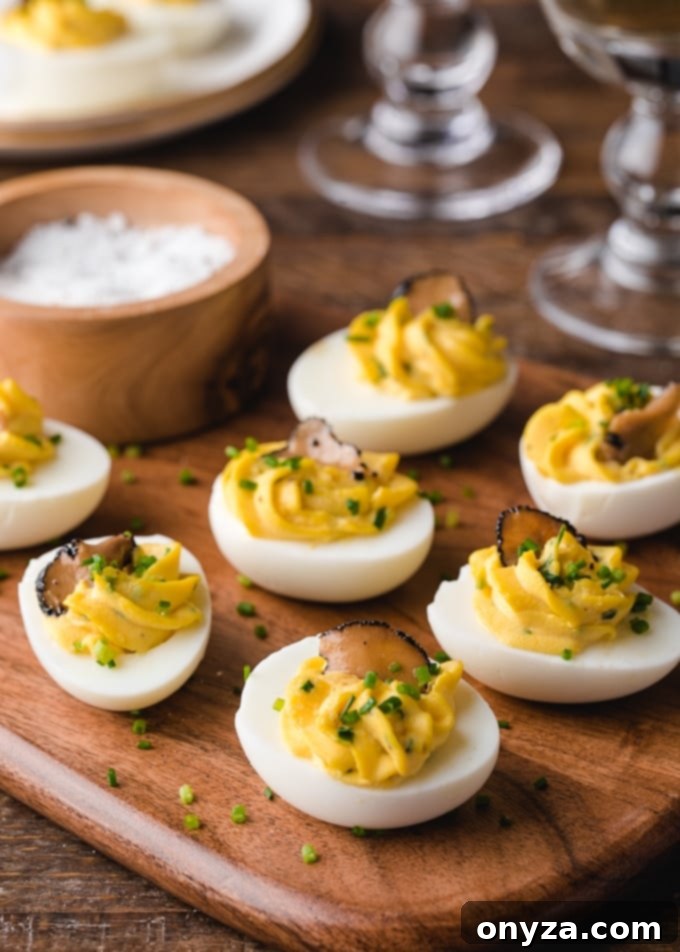Elevate your appetizer game with this exquisite Truffled Deviled Eggs recipe. This luxurious twist transforms a beloved classic into a sophisticated dish perfect for any special gathering.
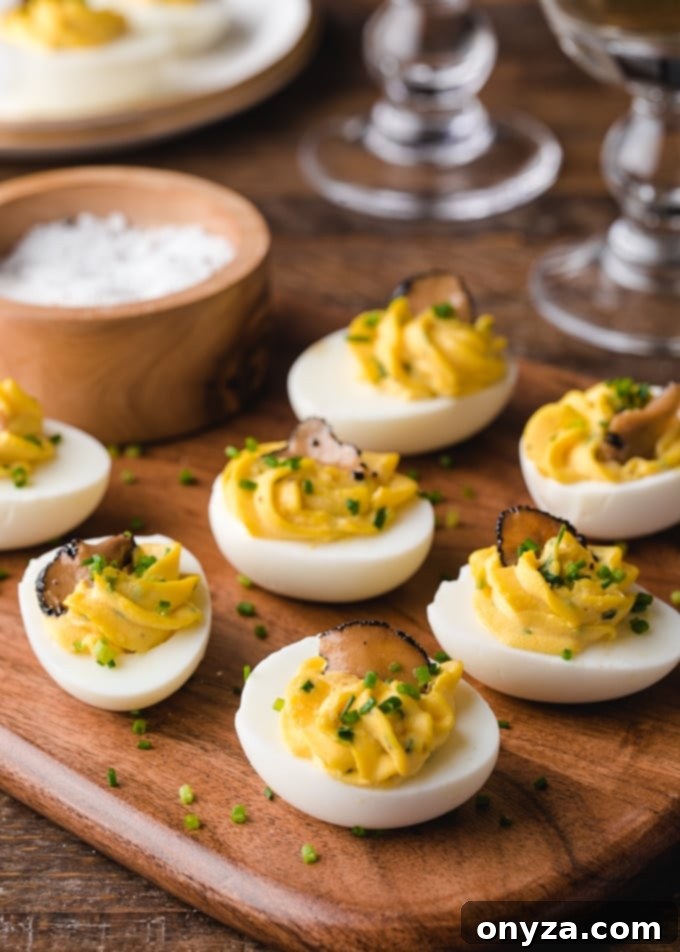
Gourmet Truffled Deviled Eggs: An Elevated Appetizer Experience
There are certain ingredients that instantly elevate a dish from ordinary to extraordinary, and for many culinary enthusiasts, truffles sit proudly at the top of that list. Whether it’s the rich aroma of freshly-shaved truffles over a creamy pasta, a decadent risotto, or the finishing touch on perfectly scrambled eggs, the allure of this underground fungi is undeniable. It’s a flavor profile that speaks of luxury, depth, and an earthy sophistication that few other ingredients can rival.
Given the magical affinity between truffles and eggs, it’s no surprise that Truffled Deviled Eggs emerge as a truly exceptional choice for a luxurious, yet wonderfully familiar, appetizer. These elegant bites are far more than just party snacks; they are a statement. Picture them gracing the tables at New Year’s Eve celebrations, sophisticated cocktail parties, or a lavish brunch spread. They offer the ideal combination: easy to prepare, visually impressive, and deliciously approachable for even the most discerning palate.
Deviled eggs, in their classic form, are a beloved staple, cherished for their creamy texture and savory flavor. But when infused with the unmistakable essence of truffle, they transcend their humble origins. This recipe isn’t just about adding a fancy ingredient; it’s about harmonizing the classic comforting elements of deviled eggs with the deep, complex notes of truffle to create a truly unforgettable culinary experience. Imagine the subtle earthy perfume hitting your senses even before the first bite, followed by the rich, creamy yolk mixture, perfectly balanced with a hint of tang and a whisper of onion from fresh chives. It’s a symphony of flavors designed to impress and delight.
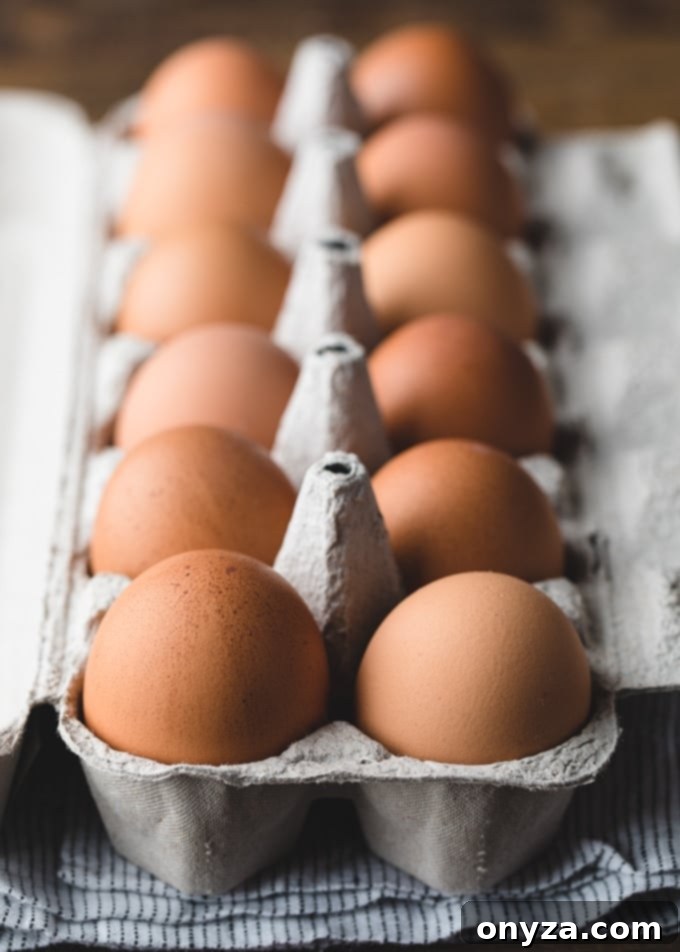
What Are Truffles? Unveiling the Earth’s Hidden Jewels
Often referred to as “the diamond of the kitchen,” truffles are an incredibly rare and prized edible fungus that grows underground, typically near the roots of certain trees like oaks, hazels, and poplars. Their appearance is deceptively humble—they look like irregular, bumpy potatoes or small, rugged rocks. What truly distinguishes them, however, is their extraordinary aroma and flavor, which can range from intensely earthy and musky to subtly garlicky, with hints of nuts, mushrooms, and even cocoa.
The hunt for truffles is a fascinating and age-old tradition. Specialized truffle hunters work with trained dogs or, traditionally, pigs, whose keen sense of smell can detect the potent aroma of truffles sometimes more than a foot beneath the soil. This meticulous and often challenging process contributes significantly to their high value and scarcity.
Varieties and Origin: A World of Fungal Finesse
Among the most coveted varieties are those originating from specific regions in Europe. Italy is renowned for its exquisite Alba white truffles (Tuber magnatum pico), found predominantly in the Piedmont region. These are arguably the most expensive and highly sought-after truffles, known for their intense, pungent aroma and garlicky notes. France, particularly the Périgord region, is famous for its black winter truffles (Tuber melanosporum), often called “black diamonds.” While less aromatic than their white counterparts, black truffles possess a more robust, earthy, and sometimes slightly chocolaty flavor that stands up well to cooking.
Beyond these two titans, other notable varieties include the summer black truffle (Tuber aestivum), which is milder and more affordable, and the Burgundy truffle (Tuber uncinatum). Each type offers a unique profile, contributing to the rich tapestry of truffle gastronomy.
The Price of Prestige: Understanding Truffle Value
The rarity and delicate nature of fresh truffles make them an expensive luxury. Their price fluctuates significantly based on the season, the specific growing region, and the abundance of the harvest. For instance, fresh black truffles can range from $90-$100 per ounce, while the elusive white Alba truffles can command $200 or even considerably more per ounce during peak season. These figures are not static; adverse weather conditions, harvest yields, and global demand can all influence market prices dramatically.
To put this into perspective, consider the historic sale in 2014 when a colossal 4.16-pound white Alba truffle fetched an astounding $61,250 at a Sotheby’s auction. Such events underscore the extraordinary status truffles hold in the culinary world, a true testament to their unique appeal and the lengths enthusiasts will go to experience their magic.
What Do Truffles Taste Like? A Sensory Journey
Describing the flavor and fragrance of truffles is a complex endeavor, as their profile is incredibly nuanced. They possess a profoundly earthy flavor and an intoxicating fragrance, often with distinct hints of garlic and shallot. There’s an unmistakable “musky” or fungal quality, coupled with notes that some describe as nutty, woody, or even reminiscent of forest floor after a rain.
The experience of freshly-harvested and shaved truffles is unparalleled. Their aroma fills the air, promising a culinary journey of deep, umami-rich flavors. It’s an ingredient that truly captivates the senses, transforming even the simplest dishes into gourmet masterpieces. When truffles are incorporated, they don’t just add a flavor; they add an essence, an entire atmosphere to the meal.
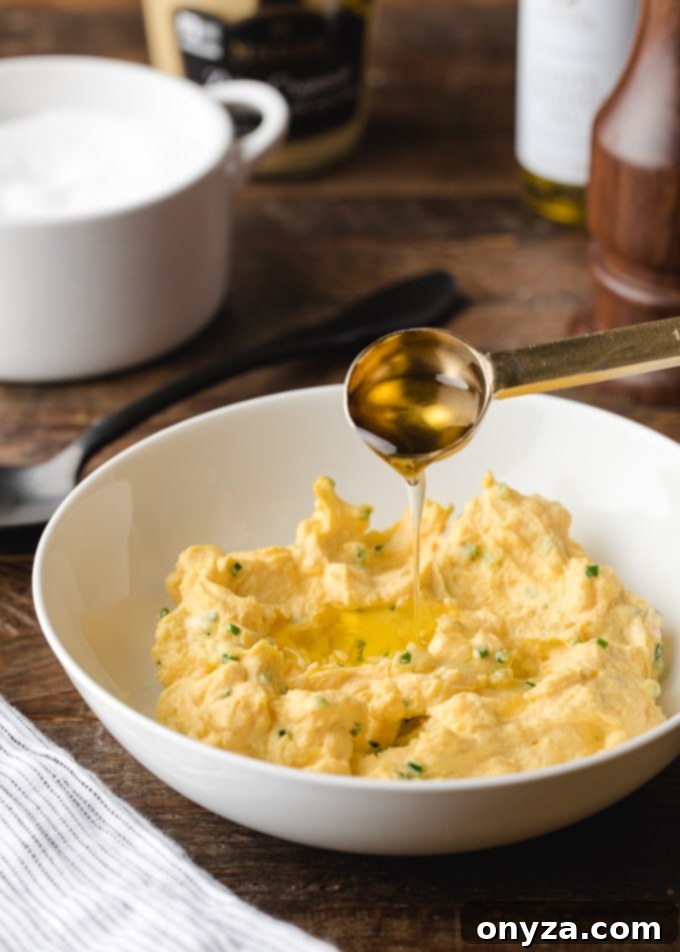
Crafting the Perfect Filling for Truffled Deviled Eggs
The heart of any deviled egg lies in its creamy, flavorful filling. For these Truffled Deviled Eggs, we start with a foundation that honors the classic while preparing it for its luxurious upgrade. The base combines smooth mayonnaise and tangy sour cream, creating a velvety texture that perfectly balances richness with a slight tartness. A touch of pungent Dijon mustard introduces a subtle spice and complexity, while fresh lemon juice provides a bright acidity that cuts through the richness and enhances all the other flavors. Finally, finely snipped fresh chives are folded in, adding a delicate onion flavor and a touch of vibrant green freshness.
To infuse this classic filling with the desired truffle essence, a carefully measured amount of truffle oil is added. You have the flexibility to choose between white or black truffle oil, depending on your personal preference and what is readily available. White truffle oil typically offers a more intense and often garlicky aroma, while black truffle oil tends to be earthier and more robust. It’s important to note that the pungency of truffle oil can vary significantly between brands, so starting with a small amount and tasting as you go is key to achieving the perfect balance.
Achieving the Ideal Hard-Boiled Eggs
The foundation of outstanding deviled eggs begins with perfectly cooked hard-boiled eggs. Overcooked eggs can lead to a greenish ring around the yolk and a rubbery texture, while undercooked eggs are notoriously difficult to peel. For optimal results, aim for yolks that are firm and vibrantly yellow, and whites that are tender yet solid.
Whether you use the stovetop method or an Instant Pot, the goal is consistently cooked eggs that peel easily. The key steps include bringing eggs to a gentle boil, immediate transfer to an ice bath to halt the cooking process, and then peeling under cool running water. This ensures a smooth, unblemished egg white cup, ready to be filled with your gourmet truffle mixture.
The Truth About Truffle Oil: Dispelling Myths and Making Informed Choices
It’s an open secret in the culinary world, but for those new to gourmet ingredients, the truth about truffle oil can be surprising: a significant portion of truffle oil on the market does not actually contain real truffles. A quick glance at the ingredient list on many bottles will often reveal terms like “truffle essence” or “truffle flavor” rather than genuine truffle pieces. These terms usually refer to a synthetic compound called 2,4-dithiapentane, which mimics the aroma of truffles.
This widespread use of synthetic flavoring has led to considerable controversy within the food industry. Acclaimed chefs, like Gordon Ramsay, have openly criticized such products, famously calling truffle oil “one of the most pungent, ridiculous ingredients ever known to chef.” Lawsuits have even been waged against manufacturers over deceptive labeling practices. So, why is synthetic truffle oil so prevalent?
There are two primary reasons. Firstly, fresh truffles are extraordinarily expensive, making it cost-prohibitive for mass production of oil infused solely with real truffles. Secondly, the delicate flavor compounds of fresh truffles are highly volatile and dissipate very quickly. A truffle oil infused only with fresh truffles would have a very short shelf life before losing its distinctive aroma.
However, not all truffle oil is created equal, and dismissing it entirely might mean missing out on a valuable culinary tool. While many cheap varieties are indeed overpowering and artificial, there are higher-quality options available. These often combine a base of good olive oil infused with a proportion of real truffle pieces and “natural” truffle extract or flavoring. The key is to look for brands that clearly state “natural truffle extract” or “natural truffle flavor” alongside real truffle infusion, and avoid those that list only synthetic compounds. These better quality oils offer a more nuanced and rounded truffle aroma, providing a pleasant, subtle earthiness rather than an aggressive chemical scent.
If you enjoy the flavor profile of dishes like truffle fries, truffle popcorn, or indeed, these truffled deviled eggs, investing a little time in finding a reputable brand of truffle oil is certainly worthwhile. It allows you to introduce that coveted truffle essence into your cooking without the exorbitant cost or fleeting availability of fresh truffles.
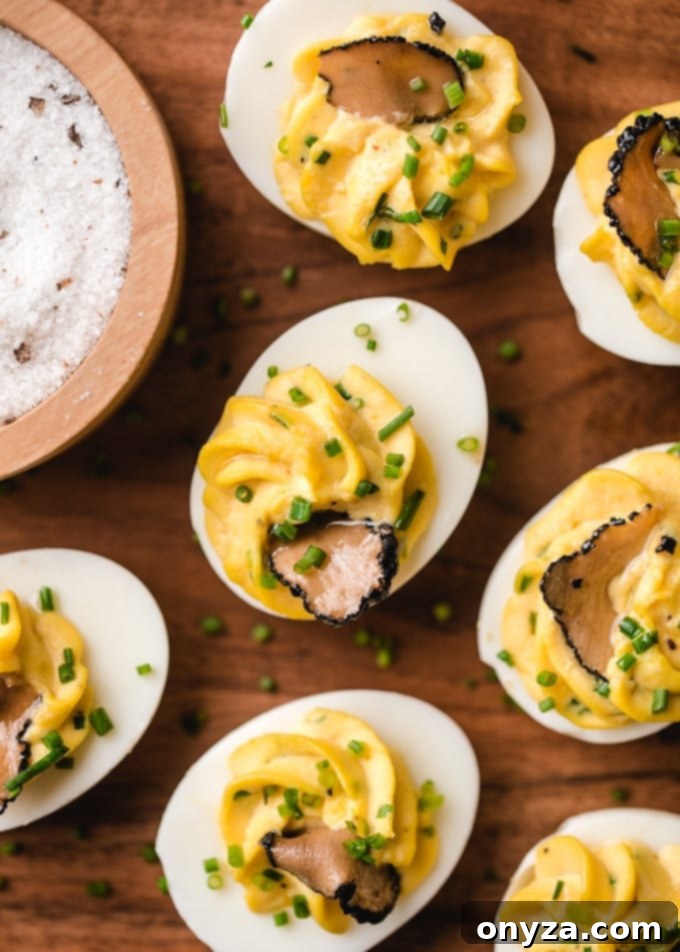
Serving Truffled Deviled Eggs: Presentation and Pairings
Presenting your Truffled Deviled Eggs beautifully is almost as important as making them taste fantastic. The visual appeal adds to the luxurious experience. I love to garnish these exquisite bites with additional snipped chives, which not only provide a vibrant pop of color but also reinforce that fresh, mild onion note. For the ultimate touch of elegance, if you have access, a delicate slice of shaved fresh truffle atop each egg half is simply unparalleled. The aroma alone will captivate your guests.
Alternatives to Fresh Truffles for Garnish
Sourcing fresh truffles can be challenging and expensive. If fresh truffles are out of reach, or you’re looking for a more economical alternative, preserved shaved truffles are an excellent option. These are typically found jarred in oil and might also be labeled as “truffle peelings” or “carpaccio.” While convenient, it’s important to set expectations: preserved truffles will not possess the same firm texture or vibrant aroma as freshly-shaved ones. Their flavor and fragrance tend to be much more muted due to the preservation process. Nevertheless, they still offer a hint of truffle luxury and a beautiful visual element.
Another fantastic option for enhancing the truffle flavor is using truffle salt. A small pinch sprinkled over the finished deviled eggs can add a burst of earthy seasoning, especially if you’re not using fresh truffles or a very potent truffle oil. Just be mindful of the salt content in the filling if you plan to use truffle salt as a garnish.
Beyond Truffles: Luxurious Pairings
For an even more extravagant presentation, Truffled Deviled Eggs are absolutely divine when paired with caviar. A tiny, glistening dollop of high-quality caviar on top of each egg half creates a stunning finish and introduces an additional layer of sophisticated salinity and texture. This pairing is particularly perfect for high-end cocktail parties and celebratory events, offering a truly memorable gourmet experience.
Consider serving these Truffled Deviled Eggs alongside a selection of other gourmet appetizers. For a varied platter, you might include:
- Classic Deviled Eggs: The timeless favorite for balance.
- Smoky Chipotle Deviled Eggs with Chorizo: For those who enjoy a little heat and spice.
- Italian Deviled Eggs: A Mediterranean-inspired twist.
- Bacon Deviled Eggs with Horseradish: A robust and savory option.
This variety ensures there’s something to please every guest, making your appetizer spread truly unforgettable.
Truffled Deviled Eggs Recipe
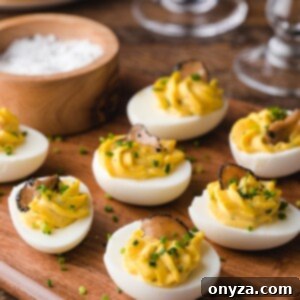
Rating: 5 from 8 votes
By: Amanda Biddle
The earthy scent of truffles combined with the classic flavors of deviled eggs makes an elegant hors d’oeuvre for any cocktail party.
Prep Time: 45 minutes
Cook Time: 15 minutes
Total Time: 1 hour
Servings: 6 servings (2 egg halves each)
Ingredients
- 6 large eggs
- 2 tablespoons mayonnaise
- 1 tablespoon sour cream
- 1 teaspoon Dijon mustard (e.g., Maille or Fallot)
- ½ teaspoon fresh lemon juice
- Quality truffle oil (to taste, see notes below)
- 2 teaspoons snipped chives, plus additional for garnish
- Shaved truffles, for garnish (optional)
- Kosher salt and freshly-ground black pepper, to taste
Instructions
Part 1: Cook the Eggs
- STOVETOP METHOD: Place eggs in a heavy-bottomed pot and cover with cool water by 1 to 2 inches. Place a lid on the pot, leaving it slightly vented, and bring the water just to a boil. Once boiling, immediately cover the pot completely, remove it from the heat, and let it stand, covered, for 12 minutes. Transfer the cooked eggs to a bowl of ice water and let them cool for at least 10 minutes before peeling under cool running water. Slice the peeled eggs in half lengthwise.
- INSTANT POT METHOD (6-Quart): Place eggs on a silicone egg holder or directly on the Instant Pot rack. Add 1 cup of water to the pot. Seal the lid and cook on the “Egg” setting or HIGH pressure for 5 minutes. Allow for a 5-minute natural pressure release, then carefully open the valve to release any remaining pressure. Immediately transfer the eggs to a bowl of ice water for 5 minutes before peeling and slicing them in half lengthwise.
Part 2: Assemble the Deviled Eggs
- Gently scoop the cooked egg yolks into a medium bowl. Using a whisk, fork, or a hand mixer (which is recommended for a smoother consistency), mash the yolks thoroughly. Add the mayonnaise, sour cream, Dijon mustard, and lemon juice, mixing until the filling is smooth and fluffy.
- Carefully stir in the truffle oil, starting with a few drops and adding more to your desired taste. Fold in the snipped chives. Season the filling generously with kosher salt and freshly-ground black pepper, adjusting to your preference.
- To fill the egg whites: You can use a small spoon for a rustic look, a piping bag fitted with a large star or plain tip for an elegant presentation, or a zip-top bag with one corner snipped off for convenience. Fill each egg white half with the creamy egg yolk mixture.
- Garnish: Sprinkle the filled deviled eggs with additional snipped chives. If using, top each with a small piece of shaved fresh or preserved truffle.
Notes
- Refer to the blog post above for detailed information on buying truffle oil. The quantity of truffle oil needed will vary based on the brand’s potency and your personal taste preferences; always start with just a few drops and increase gradually.
- If you are not garnishing with shaved truffles and wish to add an extra layer of truffle flavor, consider using truffle salt. In this case, go light on the kosher salt when seasoning the egg yolk filling, and finish each filled egg with a tiny pinch of truffle salt instead.
- For comprehensive tips and techniques on making the absolute best deviled eggs, refer to our Ultimate Guide: How to Make Deviled Eggs.
Nutrition Estimate
(Based on 1 serving, 2 egg halves)
- Calories: 123kcal
- Protein: 7g
- Fat: 9g
- Saturated Fat: 2g
- Cholesterol: 213mg
- Sodium: 121mg
- Potassium: 78mg
- Vitamin A: 335IU
- Vitamin C: 0.3mg
- Calcium: 34mg
- Iron: 1mg
Nutrition information is automatically calculated, so should only be used as an approximation.
About Our Recipes: Please note that our recipes have been developed using the US Customary measurement system and have not been tested for high altitude/elevation cooking and baking.
Like this recipe? We’d love to hear from you! Rate and leave a comment below!
